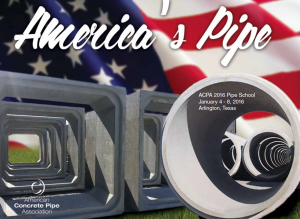Randy Wahlen, PE, Marketing Engineer for Oldcastle Infrastructure
One question those of us in the concrete pipe industry often hear is, “Why is minor cracking in concrete pipe ok?” The American Concrete Pipe Association, AASHTO and other national standards recommend that minor cracking up to 0.10” doesn’t pose a structural issue for concrete pipe. But how do we know minor cracks won’t worsen or corrode the reinforcing steel?
The answer is found in the principle of autogenous healing. Perhaps concrete’s most important property, autogenous healing is concrete’s ability to heal itself in the presence of moisture. Autogenous healing of concrete pipe is common when the buried pipe is in the presence of moisture, either on the soil side or inside the pipe itself.
Autogenous healing was first recorded in the 1830s by the French Academy of Science. Evidence that autogenous healing has occurred is a whitish substance forming along the crack line. In the presence of moisture, concrete extrudes calcium hydroxide which, upon exposure to the atmosphere, is converted to calcium carbonate (limestone) which seals the crack. Not only can concrete heal itself, the process leaves the crack stronger than the original concrete as testshave demonstrated.
However, therehasn’t been much research on autogenous healing since the 1930s.To provide a present-day example, the Mountain States Concrete Pipe Association presented a demonstration.
Mountain States Pipe Test
At the recent Mountain States Plant Tours, we posed a simple test to demonstrate autogenous healing. Although we realize it’s not a research lab-worthy experiment, our results provide positive anecdotal evidence of autogenous healing’s speed and strength.
In our experiment, we demonstrated the presence of calcium carbonate as evidence of healing and then retested the pipe after it had healed. First, we cracked a week-old pipe and measured the loads for a 0.01” crack and an ultimate crack. The initial cracks occurred at a 2,480 (0.01”) d-load and 2,875 ultimate d-load, to simulate the worst-case scenario a pipe would experience in the field. The 15” concrete pipe was then filled with water. While the cracks leaked initially, the cracks started to seal and calcium from the healing was readily evident after three days of the pipe being filled with water.
After more than a month with water in the pipe, we retested the pipe by placing it as near the same orientation as we could. The retested cracks occurred at a 3,050 (0.01”) d-load and 3,950 ultimate d-load. While the original pipe had a d-load strength that was 80 percent greater than required for a Class III pipe, its retesting in a cracked (but healed) condition gained an additional 23 percent strength. For pipes that will remain buried and in the presence of moisture for many decades, the results are expected to be even higher.
The Results
Our experiment demonstrates:
- A cracked pipe will heal in the presence of moisture
- The crack at the location of the steel reinforcement is much smaller than the surface cracks (i.e., steel corrosion needs similar environment as healing, so healing should occur first)
- The healed crack did re-crack in the same location, but larger cracks formed in other locations as the load was increased
- The pipe gained strength over time due to the healing and further hydration/curing of the concrete (i.e., a pipe that has been laid and has narrow cracks need not be repaired. The cracks will not increase over time, since load the pipe experiences during construction is a much higher load than it will experience in typical, daily performance over its lifetime.).
We were pleased to show the healed pipe took more load later than it did initially. And in a real-world situation when pipes are underground for decades, we know the pipe will likely be stronger over time than when it’s initially installed. The results provide a positive example for the concrete pipe industry that minor cracking poses no threat to the soundness of our product.
For more information on autogenous healing, visit the ACPA website’s resources on cracking: https://old.concretepipe.org/pipe-box-resources/inspection/cracks/. And leave a comment to let us know what you think about our experiment. How would you have conducted a pipe test? What would you have done differently? We’d like to hear from you!



Very well done! What a powerful demo for a plant tour! We all should be including that in our tours.
Very good info and well documented. Appropriate since Mountain States conducted previous testing that is shown in a document on ACPA website in Resources.
Great story to share!
When I was very new in my career, I served as one of several on-site staff monitoring the construction of a new water filtration plant. It took over a year to build the facility and the work included constructing several large concrete treatment tanks. After the forms were striped, the tanks were filed with water. When I asked about why we were doing that, I was told that the concrete would “heal itself” if there were any cracks. I watched the white residue develop over a period of time in small hairline cracks that randomly appeared on the surface (I don’t recall how long we left the tanks sit full of water). I do remember it was a very cool and curious experience. I think seeing helps with understanding! Great job Mountain States!
Thanks, this is really helpful demonstration to use when rumours from opponents are spread!
This was a simple but very informative test to perform. I was amazed by how fast the healing occurred. This was very helpful to show some engineers that came to the tour that had questions about Autogenous Healing. We’ll be doing something similar at concrete pipe in 2019.